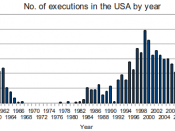The death penalty, also known as capital punishment, is the judicially ordered execution of a prisoner for a serious crime, also called a capital crime or capital offense. The term capital derives from the Latin caput, which means "head." A severe crime that was committed warrants the right for the prisoner to be executed. Prisoners sentenced to death are often segregated in their own area of the prison, known as "death row."Many methods of execution have varied over time. Some of the methods that were used are boiling to death, burial alive, crushing, drowning, and many others. The most common method is the electric chair. Thomas Edison who had financial interest in having direct current used in providing electricity developed the electric chair in the late 1880's with support.
In medieval Europe, the method of execution depended on the social class. For example, the nobility was often executed in an honorable, painless death.
An axe was used which occasionally failed. The serfs and peasants were often executed in front of the public in a painful method of execution.
Some of the crimes that warranted deaths by execution were witchcraft, religious heresy, atheism, or homosexuality. The method used for those types of crimes was usually by burning at the stake.
"According to the United Nations Secretary-General's quinquennial report on capital punishment, the highest per capita use of the death penalty is in Singapore, with a rate of 13.57 executions per one million population for the period of 1994 to 1999. The death penalty is meted out for what is considered the most serious of offenses. Out of 138 persons sentenced in the period from 1999 to 2003, 110 were for drug-related offenses, while the rest were for murder and arms-related offenses." (Capital Punishment, 2003). On Friday mornings in Changi prison executions...


